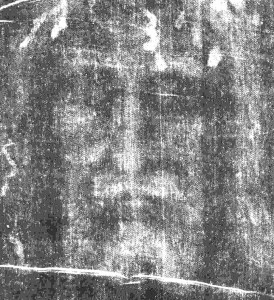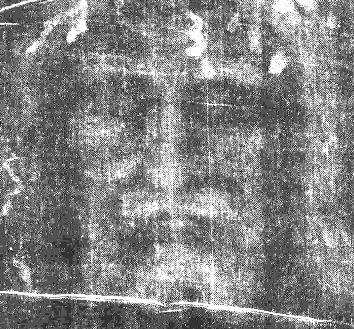Following some interesting off-blog email exchanges triggered by my recent post on the Knights Templar and the Turin Shroud, I’ve taken a fresh look at the evidence, and have a new suggestion…
The document that Barbara Frale turned up in 2003 appears to confirm a long-standing suspicion among a number of sindonologists (i.e. Shroud researchers, not people who study Donald Sinden) – that the Image of Edessa is the same thing as the Turin Shroud – and that it was secretly held & venerated by the Knights Templar between times (presumably giving rise to confused talk of kissing bearded idols, etc).
Just so you know, the Image of Edessa’s basic timeline looks like this…
- 525AD – 544AD: first appearance in Edessa – possibly hidden in a wall above a city gate
- 609: captured by the Sassanians
- 944: returned to Edessa and moved to Constantinople
- 1204: disappeared during the Sack of Constantinople
…whereas the Turin Shroud’s timeline looks like this…
- 1357: displayed in a church at Lirey by the widow of the knight Geoffroi de Charny
- 1390: Pope Clement VI allowed the shroud to be displayed
- 1418: the “Winding Sheet” entrusted to Humbert, Count de La Roche, Lord of Lirey
- 1452: given to the Duke of Savoy by Humbert’s widow Margaret
Yet there is something rather incongruous about the idea that the image on the shroud is actually of Jesus. Glen Claston points out (by email) that while early images depict Jesus much as you would expect Jews of the period to be depicted (i.e. short-haired, because nobody was allowed into temples with long hair), after 600AD images start to appear with long hair and a beard.

Glen’s understanding is that the only people at the time who had long hair were Nazirites (who took a vow not to shave their hair and abstain from grapes, wine and vinegar). In fact, probably because of the surfeit of “Da Vinci Code”-style novels and “H0ly Blood Holy Grail”-style books, the (formerly very marginal) issue of whether Jesus was a Nazirite has now become much debated.
(Incidentally, the most famous Old Testament Nazirite was Samson, which is why it was such a big deal to cut his “seven locks” – and modern Rastafarians have a creed which is apparently derived from the Nazirite vow, which is why they value herbs over alcohol. Hence one surprising issue with the Turin Shroud is whether the squiggles around the face [above] are actually proto-dreadlocks!)
That is, the culturally agreed image of Jesus started out as a mainstream Jew but around 600AD began to transform into something more like a Nazirite. But why should this be so?
My art historical suggestion (which has doubtless been made numerous times before, but what the hey, here it is again) is simply whether it was the appearance of the Image of Edessa in the sixth century which caused this change in the iconography of Jesus’ haircut. That is, rather than any subtle textual misunderstanding of “Nazarene” vs “Nazarite” (as is so often proposed), might it be that artists saw (or heard about) the ‘miraculous’ Image of Edessa and decided to use that as a visual basis for what Jesus looked like?
(Note that this is merely an hypothesis about the cultural reception of the Image of Edessa from 600AD onwards, rather than about any forensic / physical analysis of the object itself – it makes no difference whether the Shroud is genuinely miraculous or some 6th century craftsman’s subterfuge.)
Incidentally, one Turin Shroud-related issue that crops up again and again concerns the apparent height of the person wrapped in it: it is frequently asserted that this person would have been too tall to have been a Jew living two millennia ago. Yet what isn’t widely known is that there is a body of evidence that seems to imply that the Turin Shroud spent some time suspended on a kind of hanging wooden frame (probably for display in Edessa and Constantinople, it would now appear).
And so… why is the suggestion not then made that the herringbone linen of the Turin Shroud might simply have stretched lengthways under its own weight while being displayed? This might well have yielded a pervasive 10%-15% stretch, which (as I understand it) is broadly the kind of height difference in question. If you look once more at the face above, can you not see (as I do) an image that has been slightly vertically stretched? As a guide, here’s what it would look like at 85% of height:-

Turin Shroud, contrast-enhanced negative, 85% of height
Something to think about, anyway! 🙂
PS: as far as the haircut goes, I suspect that artists subsequently evolved Jesus’ haircut to a kind of worst-of-both-worlds middle-length trim – too long to be allowed in a Jewish temple, but too short to qualify as a proper Nazirite’s uncut hair. Might this be some kind of metaphor for the evolution of religion in general? I’m afraid you’ll have to work out your own moral narrative for this – I’m too busy looking at the evidence. 😉
Good post! Wikipedia states that Jesus was a practicing Jew so presumably had a beard. I remember I read something somewhere about the depiction of Jesus with long hair and a beard and that it might find its origin with some Greek philosophers called the charismatics (?). Anyway, good luck with unraveling the mystery!
Hi Nick! This is a good post.
Alas, your idea does not have priority. I remember reading long ago that paintings of Jesus may have started looking alike ca. 600 AD because they were made to resemble the Mandylion, the Image of Edessa, which might have been the Shroud of Turin. 🙁 Oh well…
Jesus was known for his bibulousness, and indeed he contrasted himself with John the Baptist in this regard (Matt. 11:18-19), so it’s unlikely he had taken Nazirite vows.
There’s an interesting and appalling idea in The Hiding Places of God by John Cornwell.
He visited the Centro Romano di Sindonologia near the Vatican and saw a life-size model of the Crucifixion based on the Shroud of Turin, “a monstrous display of cruelty quite unlike any painting of the Crucifixion I have ever seen. It was minutely detailed based on the evidence of the shroud, and one look at it convinced me once and for all that the Turin burial cloth had not been a work of imagination. But if the “model,” the victim, was not Christ, then who was it? … such is its awful sense of visual “authenticity” that we are forced at least to speculate that a human subject was involved, and that the man was almost certainly a Jew since, according to experts such as Professor Carlton S. Coon, his facial characteristics correspond exactly with the “Sephardic Jew or Noble Arab” type… we can no longer postpone reflecting on the possibility that the image is an unspeakable anti-Semitic product of barbarism manufactured in the interest of ecclesiastical commerce.” (pp. 166-9)
In other words, someone scourged and crucified a medieval Jew to produce the image on the Shroud!
However, he wrote this immediately after the C14 tests, before the subsequent controversy and the findings you mentioned in your last blog post. I’m not sure how that would affect that idea.
Dennis
I’m sorry that it’s among the books I don’t have with me, but I have a small book in which all the early imagery is brought together: including from catacombs etc. The early images show long-ish hair, shaven chin and two short tufts to each temple, as if the orthodox side-locks had been cut off. Only about the 6th century and later (if I recall) is the hair shown longer.
Traditional Jewish law forbade a man from shaving at this time. Therefore Jesus would have certainly been bearded. The hair length would have likely been longer than the modern defintion of short, cut probably just above the shoulder every 30 days in accordance with the law as to distinguish one’s self from a Nazarite. He was a Nazarene, from the city of Nazareth, a difference there. Sephardi Jews tend to fall into this appearance, especially the males with their longer hair than most Jewish men.
Nick, I’m not sure you even check these “out-of-our-current-day” discussions (April 2013), but here goes:
Barbara Frale was being so careful not “to step on Vatican toes” (her employers) that she got terribly side-tracked into confusing the Byzantine hand-painted item (the image of Edessa) with the “Shroud of Turin”. During the time Barbara was doing her research, I was duking it out with Bernie Schwartz of “Shroud dotcom”. Bernie was one of the team of investigators who, in the mid-20th century was given the tiny fragment which turned out to be a patched area on the Shroud. As recently as two years ago, he was still taking people on guided tours of “Jesus’ Shroud” of Turin.
Find Robert Lomas/Christopher Knight’s book “Second Messiah” and besides reading the book, check the appendix for the section that deals with the impaired Krebs cycle when a person is in extreme pain/shock — and just whose image was sweated onto the famous “Shroud”. It was very interesting to me, a former pre-med university student.
Fascinating, accurate, well-researched, documented, and of full of other mysteries related to Templar Knight activities.
Time for my second cuppa coffee! Ciao!
beedee
According to Dr. John Jackson from the STURP team, the excavated bodies around Jerusalem from the 1st century had heights ranging from 5’3″ to 5’11. The man on the shroud is about 5’10.5″.
He’s still a big guy, nonetheless.
On the Nazirite vs Nazarene issue: I find it interesting that in the letters of Paul, he is described as being “a ringleader of the Nazarenes.” He also describes going to temple to get a haircut, something a Nazirite was supposed to do when he ended a seven year stint of uncut hair. Personally, I do not think that Jesus being a Nazarene meant he was necessarily from Nazareth. It wouldn’t make sense for Pontius Pilate to identify and advertise this pretender to the Jewish throne as being from an otherwise unknown village in a province. Nazarenes were an ultra ultra right wing faction of one of the parties in Israel at the time, the Essenes. John the Baptizer is described as a religious fanatic from a nice religious family, who chose to announce the coming of the Redeemer of the nation in the guise of a desert prophet. Minimal clothes, minimal vegetarian diet, wild appearance. Describes the peculiar sect, according to Josephus. After examining closely details of the hair of the man on the shroud, an observation was made that a distinct weave pattern could be detected. Would make further sense, wouldn’t it? That the leader of a large movement, a leader known as rabbi, might have his hair taken care of? Of course that suggests that the leader, a first century second temple period wandering spiritual leader with a large retinue of men, women, children, animals, would have a wife, or at least a beloved to take care of such issues.